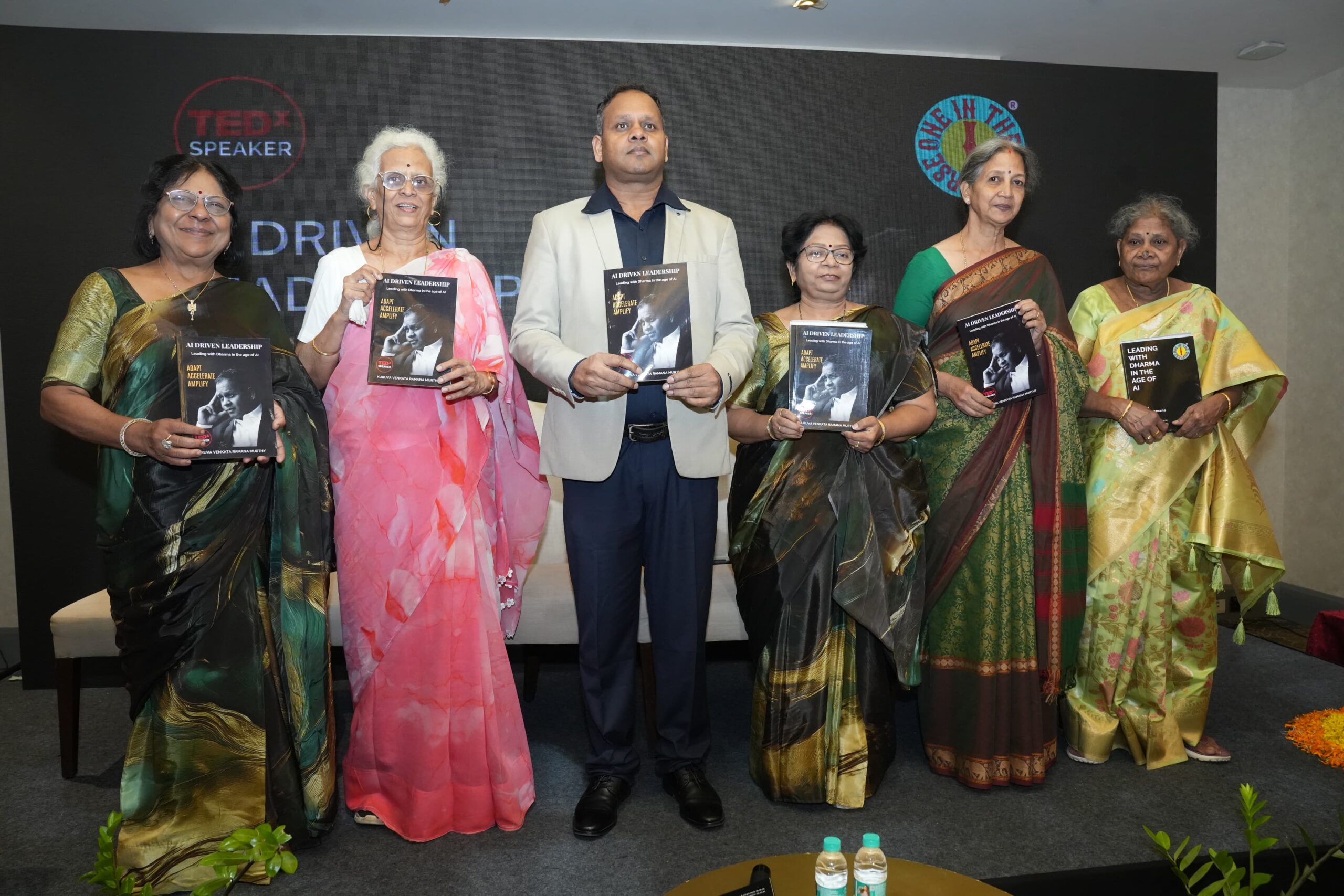
In a time when Artificial Intelligence is accelerating decision-making and automating human judgment, one voice from India is calling for a radical pause. With the launch of his new book, AI-Driven Leadership: Leading with Dharma in the Age of AI, leadership strategist and author Kuruva Venkataramana Murthy is asking a deeper question: What happens to the soul of leadership when systems become smarter than their makers?
The book, now available across major bookstores and platforms, is not just a playbook for adapting to technology it’s a philosophical intervention. It places Dharma, the Indian concept of righteous action and inner balance, at the center of decision-making in a machine-first world.
But before the frameworks, philosophies, and strategic tools, there was an unusual moment at the book’s Hyderabad launch: mothers unveiling the book. It wasn’t a celebrity endorsement or a corporate ribbon-cutting. It was a quiet, symbolic gesture, rich in meaning.
“In an age dominated by speed, data, and automation, we wanted to ground our message in what is eternal not just efficient,” Murthy shared. “And nothing embodies Dharma our essence of responsibility and care more than a mother.”
For a book about navigating the artificial, its starting point was unmistakably human.
Reframing Leadership for the Algorithmic Age
AI-Driven Leadership: Leading with Dharma in the Age of AI emerges at a critical juncture. Leaders across sectors are racing to keep up with AI disruption but few are pausing to reflect on the ethical gaps, cultural oversights, and emotional burnout that accompany this pace.
Murthy identifies three widening fault lines in modern leadership:
1. Integrity Gap – Where values are declared, but not embedded in systems.
2. Awareness Gap – Where speed overtakes space for reflection.
3. Relevance Gap – Where decisions no longer align with people’s lived realities.
Rather than offering linear solutions, Murthy introduces a cyclical leadership rhythm: the AAA Framework Adapt, Amplify, Accelerate each step rooted in Indian philosophical principles.
The AAA Model: Where Dharma Meets Design
At the heart of Murthy’s proposition is the idea that Dharma is not abstract. It can be structured, applied, and scaled if leaders learn to lead from within.
● Adapt with Inner Clarity: Through practices like Swadhyaya (self-inquiry) and Sama (equanimity), leaders are urged to respond with awareness rather than reaction.
● Amplify with Ethical Discernment: Using Viveka (discernment), they are taught to scale only what aligns with values not what’s merely profitable.
● Accelerate with Human Alignment: Anchored in Sankalpa (intentionality) and Sambandh (relationship), speed is reframed as soulful scaling, not soulless sprinting.
What makes this model stand out is its blending of ancient wisdom with practical application. The book includes decision flowcharts, empathy loops, and rituals for reflection tools to make Dharma livable in the boardroom.
Panchsheel for Ethical AI: Leadership Beyond Efficiency
One of the book’s most striking contributions is the articulation of a Panchsheel for AI Leadership five principles inspired by ancient Indian philosophy, reimagined for algorithmic times:
1. Satyam (Truth) – Data should represent real, lived truths not distortions or optimizations.
2. Ahimsa (Non-Harm) – Tech systems must avoid emotional, cultural, and psychological harm.
3. Seva (Service) – AI should uplift the underserved, not just the powerful.
4. Viveka (Discernment) – Decisions must be transparent and ethically justified.
5. Sambandh (Connection) – Human relationships should be enhanced, not replaced.
These are not abstract values they are intended as filters for design, whether for an AI-driven HR tool or a scaled public health platform.
What Readers Are Saying
Early feedback suggests that AI-Driven Leadership is resonating far beyond the corporate world.
“I was afraid of AI until I read this. Now I feel prepared not just technically, but spiritually.” Parul, Business Consultant TCS
“This book didn’t just tell me how to lead. It asked me why I’m leading at all.” Aditi, Creative Design Director
“It made me pause. And I think that’s what leadership today needs most.” Naina, Senior Manager
The book doesn’t claim to have all the answers. Instead, it acts as a mirror inviting readers to develop what Murthy calls “contextual intelligence” the ability to act with clarity, grounded in culture, history, and conscience.
A Framework Rooted in the Future but Anchored in the Past
Through his organization One in the Universe, Murthy has been working to integrate storytelling, spiritual clarity, and systems thinking across fashion, publishing, leadership training, and art. His previous works and coaching frameworks have been adopted by founders, government officers, and Fortune 500 executives. This new book consolidates years of practice, inquiry, and mentoring into a single guide for future-makers.
As AI redefines scale, power, and productivity, Murthy’s book insists that the next great revolution won’t be coded. It will be remembered by those who choose to lead not from ambition, but from alignment.
And perhaps that’s why the book opened with mothers. As Murthy puts it, “They are our first leaders. They teach us how to listen, how to hold, how to be still. That is the leadership the world needs now.”








